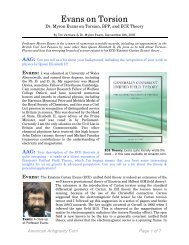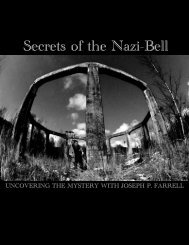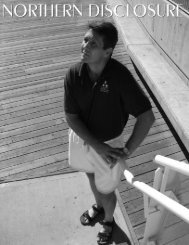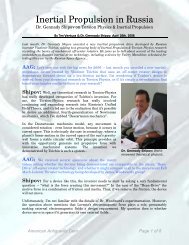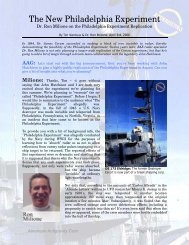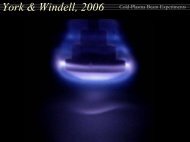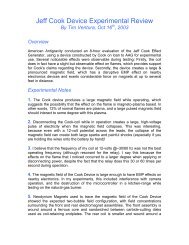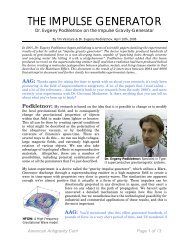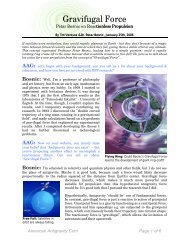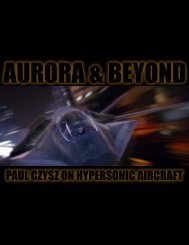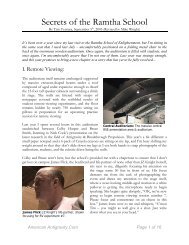The New Nazi Bell - American Antigravity
The New Nazi Bell - American Antigravity
The New Nazi Bell - American Antigravity
- No tags were found...
You also want an ePaper? Increase the reach of your titles
YUMPU automatically turns print PDFs into web optimized ePapers that Google loves.
<strong>The</strong> <strong>New</strong> <strong>Nazi</strong> <strong>Bell</strong>By Tim Ventura, November 14 th , 2005 (revised 2011)In 2001, a California defense contractor attempted a replication of the <strong>Nazi</strong> <strong>Bell</strong>experiment. It worked. Get the inside story behind “Einstein’s <strong>Antigravity</strong>” and learnhow modern scientists reverse-engineered one of WWII’s greatest mysteries…IntroductionIn September 2004 I met John Dering inan online scientific newsgroup, and as I gotto know him he began sharing details aboutthe <strong>Nazi</strong> <strong>Bell</strong> project that we ended uppublishing together in a story called“Einstein’s <strong>Antigravity</strong>”.Our goal was to make a case for the ideathat Einstein’s Unified Field <strong>The</strong>ory playeda role in the development of both the <strong>Nazi</strong><strong>Bell</strong> project as well as the US Navy’sPhiladelphia Experiment during theSecond World War.<strong>The</strong> <strong>Nazi</strong> <strong>Bell</strong>: No evidence remains otherthan this abandoned test-rig…or does it?John Dering is the chief-scientist for a defense-contractor called SARA located inCypress, California. He's got a Master's Degree in Laser Physics, and worked for a whileat TRW, so he's been around for long enough to hear some of the more interestingstories. He was particularly passionate about the <strong>Nazi</strong> <strong>Bell</strong> story because of his closefriendship with Dr. James Corum, who was an expert on Einstein’s Unified Field <strong>The</strong>ory,and also because his company worked on a scale-replication experiment based on theprinciples behind the <strong>Nazi</strong> <strong>Bell</strong> project: and according to Dering, it produced results.I talked to John almost every day for about 3 months, collecting data the entire time towrite a story on the <strong>Nazi</strong> <strong>Bell</strong> device. <strong>The</strong> <strong>Bell</strong> project that he'd been involved with wasrelated to WW-II German research, but the modern replication had been financed by JoeFirmage's ISSO startup for about 1.2 million dollars, and wasn't an exact replica of theoriginal device. SARA's version was much smaller -- using only about 100 watts -- andthey'd modified the design, since they didn't actually know many of the details of theoriginal <strong>Bell</strong>’s construction.My understanding is that SARA became aware of the <strong>Nazi</strong> <strong>Bell</strong> project when IgorWitkowski first broke the story. Given the sensitive nature of the technologies that SARAtypically works with, they were intrigued enough with it to accept a contract to attempt areplication of it when they were approached by Joe Firmage’s ISSO organization.SARA does both public and private-sector technology development I gather that theycontributed what they felt could help make the project successful based on the financingand risk Firmage was willing to assume in the project. In order to understand what theybuilt, it helps to understand how the SARA team interpreted Witkowski's research basedon their own experience and expertise, so let’s with Dering’s perspective:<strong>American</strong> <strong>Antigravity</strong>.Com Page 1 of 6
<strong>The</strong> <strong>Nazi</strong> <strong>Bell</strong>According to John Dering, the basis for the<strong>Nazi</strong> <strong>Bell</strong> Project is Einstein's Unified Field<strong>The</strong>ory. Supposedly, Albert Einstein hadnearly completed a version of his UFT whenhe fled Germany in 1933.<strong>The</strong> 1930's versions of the UFT are supposedto be more useful for gravity-modificationthan the later 40's versions, where heapproached the issues from a very differentperspective. Einstein took the theory withhim when he fled, but he'd worked closely onit with Walther Gerlach in the 20's, who laterbecame one of Germany's top wartimephysicists.It’s important to remember that the <strong>Bell</strong>project was completely compartmentalized –that’s why they placed it at Wenceslas Mine.Because of this isolation, the story remaineduntold until Igor Witkowski stumbled acrossit while following up on a Polish folk-taleabout what was basically a “ghost-mine” thatthe locals had been afraid of since the war.Plasma Focus: Witkowski suggested thatthe <strong>Bell</strong> was similar to this fusion device.Igor Witkowski wrote this up in a book called “Truth about the Wunderwaffe”, which isthe inspiration for the condensed version that most people have seen in Cook’s “Zero-Point”. I spent $80 for “Truth about the Wunderwaffe”, and it was worth every penny…<strong>The</strong> Truth about the Wunderwaffe contained over 50 pages of details about the <strong>Bell</strong>project, including project funding and oversight documents pertaining to the project thatWitkowski dug up from musty war-era archives. Witkowski described the <strong>Nazi</strong> <strong>Bell</strong> asbeing very similar to a “plasma-focus”, a design comparable in some ways to high-energydevices used in fusion research.Nick Cook effectively summarized the construction of the <strong>Nazi</strong> <strong>Bell</strong> as follows: “<strong>The</strong> <strong>Nazi</strong><strong>Bell</strong> device consisted two of counter-rotating cylindrical containers. <strong>The</strong> containers,which were positioned one above the other measured approximately 1-meter indiameter, and were filled with cryogenically cooled and frozen Mercury metal. <strong>The</strong>rewas a frozen core of a metallic paste, which served as a “high permeability material”for the EMG (electromagnetic-gravitational) field.”This is where John Dering's story essentially begins – the point where Igor Witkowskiand Nick Cook’s research effectively ends. While they both did an impeccable job ofresearching the historical data associated with the <strong>Bell</strong>, they offer little speculation onhow it might have been designed, other than Witkowski’s suggestion that it was based onthe principles of Quantum Mechanics, but John Dering suggests something different.<strong>American</strong> <strong>Antigravity</strong>.Com Page 2 of 6
John Dering starts out with the claim that Walther Gerlach had been behind both the<strong>Nazi</strong> <strong>Bell</strong> Project and something called the "Rhine Valley" experiments. <strong>The</strong>se mighthave been the "foo-fighters", but the idea John expressed was that they were aspects ofthe same technology. <strong>The</strong> <strong>Bell</strong> was a propulsion system, probably <strong>Antigravity</strong> -- and theRhine Valley experiment was a weapons-system based on some deadly side-effects thathad been noticed during testing of the <strong>Bell</strong>.Dering didn't elaborate much on the Rhine Valley experiments, except to say that theyalso incorporate something called "Zenic" or "Zinsser" surface-waves (can't rememberwhich). <strong>The</strong>se are apparently a very efficient method of transmitting electricity throughthe ground, and involve the calculation ofcomplex resonant frequencies. It soundslike Tesla, but apparently was a veryrigorous mathematical process that let theGermans supposedly blanket the valleywith a field that normally wouldn't reachmore than a hundred feet. <strong>The</strong>se are alsothe basis for some new engineering projectsthat John's dreamed up, such as building a"hovercraft" that uses Lenz-Levitation atvery low power-levels to hover over thesesurface-waves imparted via RFtransmittersto the ground below.<strong>The</strong> Flytrap: A modern-day equivalent ofthe <strong>Bell</strong> test-site, used for helicopter testing.<strong>The</strong>se projects were financed throughdifferent channels, and located in areas soremote that even the secret-weapons scientists at Peenemunde didn't know they existed.Only a few managerial types did, one of these being SS General Hans Kammler, whoapparently had military oversight for the project, as well as several other top-secretendeavors.Whatever the <strong>Bell</strong> actually was, at the end of the war Kammler picked it above all othersto take with him into hiding. It's suspected that he may have traded this for asylum inwhatever country he landed in, but the fact that he took it was a powerful statement. <strong>The</strong>Reich had been working on a number of interesting projects, including air-breathingCoanda-Effect saucers. Those were burned on the runway to prevent the Allies fromtaking them, but the <strong>Bell</strong> was physically removed to Norway via a Junker's transportplane,and then lost to the winds of history...<strong>The</strong> Philadelphia ExperimentDering's story also included a large section on the Philadelphia Experiment, which heclaimed originated again from Einstein's Unified Field <strong>The</strong>ory. To give John credit, theguy has a nearly photographic memory. He'd quoted me sections of 1979 "<strong>The</strong>Philadelphia Experiment" book by William Moore from memory that were nearlyidentical to passages in the copy that I bought for reference information.In the case of the Philadelphia Experiment, however, Dering wasn't acting alone: a majorpart of the story came from Dr. James Corum, a PhD EE who'd actually conducted areplica of the Philadelphia Experiment in 1994, and then published the results for othersto use in their own experiments. Corum had translated Einstein's UFT a while back fromGerman to English, and had been struck by several passages from Carlos Allende that<strong>American</strong> <strong>Antigravity</strong>.Com Page 3 of 6
were simply too scientifically accurate to have come from a 1950's merchant-marinesailor who'd dropped out of high-school.Corum’s 1994 replication included solid physics & great historical research, which Iquoted in “Einstein’s <strong>Antigravity</strong>”:“During the war, the Germans had a radarreductionprogram underway to reduce theradar-cross section of a ship based on theconcept of impedance matching. It wasknown that magnetic biasing of an iron orsteel medium can control the surfaceimpendence, and the use of degaussing coilsto achieve this is likely due to heavyexperimentation with them during the warto reduce naval ship’s susceptibility toattack by magnetically detonated mines ortorpedoes.”So the <strong>Bell</strong> story itself is nearly all JohnDering, and the Philadelphia Experimentstory is a combination of Dering & Corum.<strong>The</strong>se guys are both really sharp, and bothhave great memories. <strong>The</strong>y haven't talked toeach other in over 7 years, but when I crossreferencedtheir stories, I didn't even have totake notes from Corum, since his phrasingwas identical to what Dering had told me.Same story, amazing as that sounds...DE 173 Eldridge: <strong>The</strong> former DestroyerEscort is now part of a Greek shipping corp.<strong>The</strong>y found some interesting tidbits about this that nobody else seems to have picked upon. First of all, Dering claims that Bismuth was important to the accidental effectscausing the melting-decks and other anomalies in the Philadelphia Experiment, due tothe role of Bismuth acting as something similar to a transformer core for gravitationaleffects.I've heard that unpaired nuclear spin might be the cause for this, but whatever the case,Bismuth has been part of the folklore for nearly 100 years as being important to gravityeffects.Dering claims that it was present in the DE 173 Eldridge to increase the flexibilityof the hull-welds. It was a good, non-toxic material to use during wartime construction,and didn't compete with lead (used for bullets) in the military supply-chain. <strong>The</strong>y werebuilding ships so fast that the hull-welds were cracking, so they added Bismuth as asoftener to solve the problem. Thus, the ship was shot-through with this substance, andthe gravitational anomaly was contained or amplified as a result.<strong>The</strong>re's been some debate about whether the Philadelphia Experiment was trying toachieve true optical invisibility, or perhaps just some type of primitive "stealth" radarinvisibility. I don't recall Dering addressing this in detail, but the PhiladelphiaExperiment book contains a passage by a "Dr. Rinehart" that speaks about usingEinstein's UFT calculations to bend visible-light around a ship. Certainly it worked forradar -- Corum's 1994 experiment proved that. Rinehart is another interesting tidbit thatI found some inside info on...<strong>American</strong> <strong>Antigravity</strong>.Com Page 4 of 6
When William Moore wrote "<strong>The</strong> Philadelphia Experiment" book in 1979, he caught upwith an individual mentioned by Carlos Allende under the pseudonym of "Dr. FranklinReno". This Reno character was supposed to be a scientist on the PhiladelphiaExperiment during the war, which makessense -- again, Carlos Allende was a 1950'sera merchant-marine sailor with noeducation: there's no way he could haveeffectively talked about Einstein's UnifiedField <strong>The</strong>ory, which is complex enough thatit still confuses physicists today.<strong>The</strong> Eldridge: Power-cables from the Phil.experiment are still visible 50 years later.Moore found this "Franklin Reno"character hiding someplace like Arizona,still paranoid about the governmenttracking him down. Reno wasn't his realname -- so Moore called him "Dr. Rinehart"and then stated that this was just anotherpseudonym. <strong>The</strong> interesting part is thatDering actually knows Bill Moore prettywell, and claims that this was Moore'sinteresting way of hiding something in plain-sight. Rinehart wasn't a pseudonym; Moorehad used this person's real name in the book, which corresponds to records of a Dr.Rinehart working as a physicist specializing in Naval Degaussing Equipment in thePhiladelphia Navy Yard in 1943.That's also what Einstein was doing during the war -- working on "a device to explode atorpedo under a ship" at the Philadelphia Navy-Yard in 1943. Given his specialization &skills, and the fact that everybody else was working on Einstein's proposal (the nuclearbomb), it doesn't seem irrational to assume that Einstein was working on thePhiladelphia Experiment.Einstein's Unified Field <strong>The</strong>orySo what happened with both the <strong>Bell</strong> and the Philadelphia Experiment? Here we havetwo experiments based on similar principles, completely cutoff from each other due towartime secrecy...and yet they produce remarkably similar results. <strong>The</strong> key, I believe, isthat these are both true torsion fields, in that they bend the fabric of time-space into avariety of shapes.Dering suggests that folding space-time is a bit like origami: lots of shapes, and they havedifferent effects. Some of these effects can destabilize nuclei, creating radiation -- otherscreate a back EMF effect that can't be shielded. On a larger scale, these same effects cancreate <strong>Antigravity</strong>, jellification of metals, and things spontaneously disappearing fromour reality (like the Eldridge). Basically, Dering is describing a basis in physics for theHutchison-Effect.<strong>The</strong> chief complaint about Einstein's UFT is that "it was never finished", and that"Einstein wasn't happy with it". Very well -- however, it did work well enough that GE'sChief-Scientist Gabriel Kron used the UFT to derive solutions for issues like phase-creepin large, synchronous electrical systems. As it turns out, these torsion physics effects arearound us all the time, but they're usually so small that nobody notices them.<strong>American</strong> <strong>Antigravity</strong>.Com Page 5 of 6
<strong>The</strong> key is power: these effects are non-linear in nature. <strong>The</strong>y don't require terawatts perparticle like the Quantum Mechanics community would suggest, but they do appearmore readily when you have a lot of energy compressed into a small area -- like in a largeelectrical generator, or in a series of degaussing coils powered by multi-megawattgenerators. <strong>The</strong>se are bulk-matter effects: they become more efficient with scale and size,so the couplings aren't the type of thing that will ever show up in QuantumMechanics...it's a lot of low-energy particles that modify time-space, not a single highenergyparticle.So in essence, on a small-scale the UFT does nothing: on a large scale, it's possible thatthe Eldridge literally became a "standing-state warp-drive", and god knows about the<strong>Nazi</strong> <strong>Bell</strong>. Some visitors have gone to the <strong>Bell</strong> test-site to measure the concrete test-rigthey call "the flytrap". <strong>The</strong> off-the-cuff estimates place it structurally at being able tosupport up to maybe 100 tons of weight, so despite a lack of records for the actual testresults, <strong>The</strong> <strong>Nazi</strong>’s were obviously planning for something pretty powerful.<strong>The</strong> <strong>Nazi</strong> <strong>Bell</strong> ReplicationWhatever the post-war research might have been, the contemporary research seems tosurpass: SARA tested their mini-version of the <strong>Bell</strong> and found that it effectively produceda gravitational back-EMF that they couldn't shield against. That's important, becauseSARA does electromagnetic shielding on the B-2 bomber....they tried everythingimaginable before realizing that it was a time-space distortion effect. <strong>The</strong>y shut theexperiment down when ISSO funding dried up, although the claim is that if the cash isavailable, they still have the unit ready & waiting for more tests.Test-Rig Top: Another shot of the top ofthe <strong>Bell</strong> rig from the anonymous source.Despite losing project funding, John Deringhasn't stopped his research. He's workingwith a computer-model of Corum'stranslation for Einstein's UFT, andapparently it's producing curl-vectors,which is a first in computer modeling forthis type of theory. Also, they've preppedthe experiment a bit in the event that theyreceive funding in the future: they canboost power to their RF-input signal from100 to 1,000 watts quite effectively,although they're not sure what the resultswill be. Hopefully they’re not too profound,since it could actually be dangerous if theypass the non-linear output threshold.Tim Ventura is the Founder of the <strong>American</strong> <strong>Antigravity</strong>, the leader in antigravity &disruptive tech since 2002. Read more online at: http://www.americanantigravity.com<strong>American</strong> <strong>Antigravity</strong>.Com Page 6 of 6



